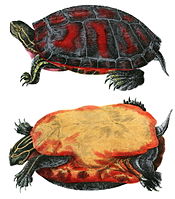| Yellow-blotched map turtle | |
|---|---|

| |
| Conservation status | |
 Vulnerable (IUCN 3.1) | |
 Threatened (ESA) | |
| Scientific classification | |
| Domain: | Eukaryota |
| Kingdom: | Animalia |
| Phylum: | Chordata |
| Class: | Reptilia |
| Order: | Testudines |
| Suborder: | Cryptodira |
| Superfamily: | Testudinoidea |
| Family: | Emydidae |
| Genus: | Graptemys |
| Species: | G. flavimaculata |
| Binomial name | |
| Graptemys flavimaculata Cagle, 1954 | |
| Synonyms | |
The yellow-blotched map turtle (Graptemys flavimaculata), or yellow-blotched sawback, is a species of turtle in the family Emydidae. It is part of the narrow-headed group of map turtles, and is endemic to the southern United States.
Geographic range

Its distribution is limited to the Pascagoula River of Mississippi and most of its tributaries (a range it shares with the Pascagoula map turtle).
Home range
Males have a mean home range area of 1.12 ha (2.77 acres) and a mean home range length of 1.8 km (1.1 mi). Females have a mean home range area of 5.75 ha (14.20 acres), due to nesting activities, and a mean home range length of 1.5 km (0.93 mi).
Description
Yellow-blotched map turtles are medium- to small-sized turtles, with males ranging from 3.5 to 4.5 in (9-11.5 cm) in carapace length as adults. Adult females are larger, about 5 to 7.5 in (13–19 cm) in carapace length. The yellow-blotched map turtle has the highest central keel of all map turtles.
Diet
Yellow-blotched map turtles feed mostly on insects, but are opportunistic feeders, so also consume crustaceans, fish, and some fresh plant matter.
Conservation status
This species is listed as threatened under the US Endangered Species Act due to a recent decline. This can be attributed to a low reproductive frequency as compared with most other map turtles. A high level of nest mortality due to fish crow predation and river flooding are also attributed to endangerment. Unexpectedly high occurrences of nesting in shaded areas could possibly be attributed to human disturbances on and near sandbars, which raises mortality rates. Human disturbances are primarily boating activities that are popular in the Pascagoula of Mississippi increasing the female turtle's energetic cost of nesting overall preventing their population to grow.
Also, its habitat suffers from pollution and agricultural changes to water levels, affecting nesting beaches. "Turtle plinking", shooting turtles for casual target practice, kills significant portions of this endangered turtle's population each year.
Since yellow-blotched map turtles are freshwater turtles mainly found in the Pascagoula River of Mississippi, human disturbances like an increase in boats in the area of inhabitance, also leads to many physiological issues due to less time to bask or endangerment of the nest.
As a member of the listed Graptemys genus, G. flavimaculata receives protection under Appendix III of the Convention on International Trade in Endangered Species of Wild Fauna and Flora (CITES).
References
- van Dijk, P.P. (2016) . "Graptemys flavimaculata". IUCN Red List of Threatened Species. 2011: e.T9498A97418378. doi:10.2305/IUCN.UK.2013.RLTS.T9498A12996484.en. Retrieved 29 October 2022.{{cite iucn}}: |volume= / |doi= mismatch, |date= / |doi= mismatch (help)
- "Yellow-blotched map turtle (Graptemys flavimaculata)". Environmental Conservation Online System. U.S. Fish & Wildlife Service. Retrieved 22 May 2023.
- 56 FR 1459
- Fritz, Uwe; Havaš, Peter (2007). "Checklist of Chelonians of the World". Vertebrate Zoology. 57 (2): 187. doi:10.3897/vz.57.e30895.
- Conant, R. 1975. A Field Guide to Reptiles and Amphibians of Eastern and Central North America, Second Edition. Houghton Mifflin. Boston. xviii + 429 pp. + 48 plates. ISBN 0-395-19977-8 (paperback). (Graptemys flavimaculata, p. 59 + Plate 8 + Map17.)
- Jones, R. L. (1996). "Home Range and Seasonal Movements of the Turtle Graptemys flavimaculata". Journal of Herpetology. 30 (3): 376–385. doi:10.2307/1565175. JSTOR 1565175.
- Horne, Brian D.; Brauman, Robert J.; Moore, Megan J. C.; Seigel, Richard A. (December 2003). "Reproductive and Nesting Ecology of the Yellow-Blotched Map Turtle, Graptemys flavimaculata: Implications for Conservation and Management". Copeia. 2003 (4): 729–738. doi:10.1643/HA02-213.1. S2CID 86331793.
- Moore, Megan J. C.; Seigel, Richard A. (1 July 2006). "No place to nest or bask: Effects of human disturbance on the nesting and basking habits of yellow-blotched map turtles (Graptemys flavimaculata)". Biological Conservation. 130 (3): 386–393. Bibcode:2006BCons.130..386M. doi:10.1016/j.biocon.2006.01.001.
- "Top 25 Turtles On Death Row" (PDF) (Press release). Turtle Conservation Fund. 15 May 2003.
- Selman, Will; Qualls, Carl; Owen, Jennifer C. (July 2013). "Effects of human disturbance on the behavior and physiology of an imperiled freshwater turtle: Disturbance Impacts on Turtles". The Journal of Wildlife Management. 77 (5): 877–885. doi:10.1002/jwmg.538. JSTOR 43188086.
- "Appendices I, II and III". Convention on International Trade in Endangered Species of Wild Fauna and Flora. 21 May 2023. Retrieved 22 May 2023.
Further reading
- Cagle, Fred R. (26 August 1954). "Two New Species of the Genus Graptemys" (PDF). Tulane Studies in Zoology. 1 (11): 165–186.
- Smith, H.M., and E.D. Brodie Jr. 1982. Reptiles of North America: A Guide to Field Identification. Golden Press. New York. 240 pp. ISBN 0-307-13666-3 (paperback). (Grapemys flavimaculata, pp. 52–53.)
| Emydidae family | ||||
|---|---|---|---|---|
| ||||
| Genera |
|  | ||
| Chrysemys | ||||
| Clemmys | ||||
| Deirochelys | ||||
| Actinemys | ||||
| Emys | ||||
| Emydoidea | ||||
| Glyptemys | ||||
| Graptemys | ||||
| Malaclemys | ||||
| Pseudemys | ||||
| Terrapene | ||||
| Trachemys | ||||
| †Wilburemys | ||||
| Phylogenetic arrangement of turtles based on turtles of the world 2017 update: Annotated checklist and atlas of taxonomy, synonymy, distribution, and conservation status. Key: †=extinct. | ||||
| Taxon identifiers | |
|---|---|
| Graptemys flavimaculata | |